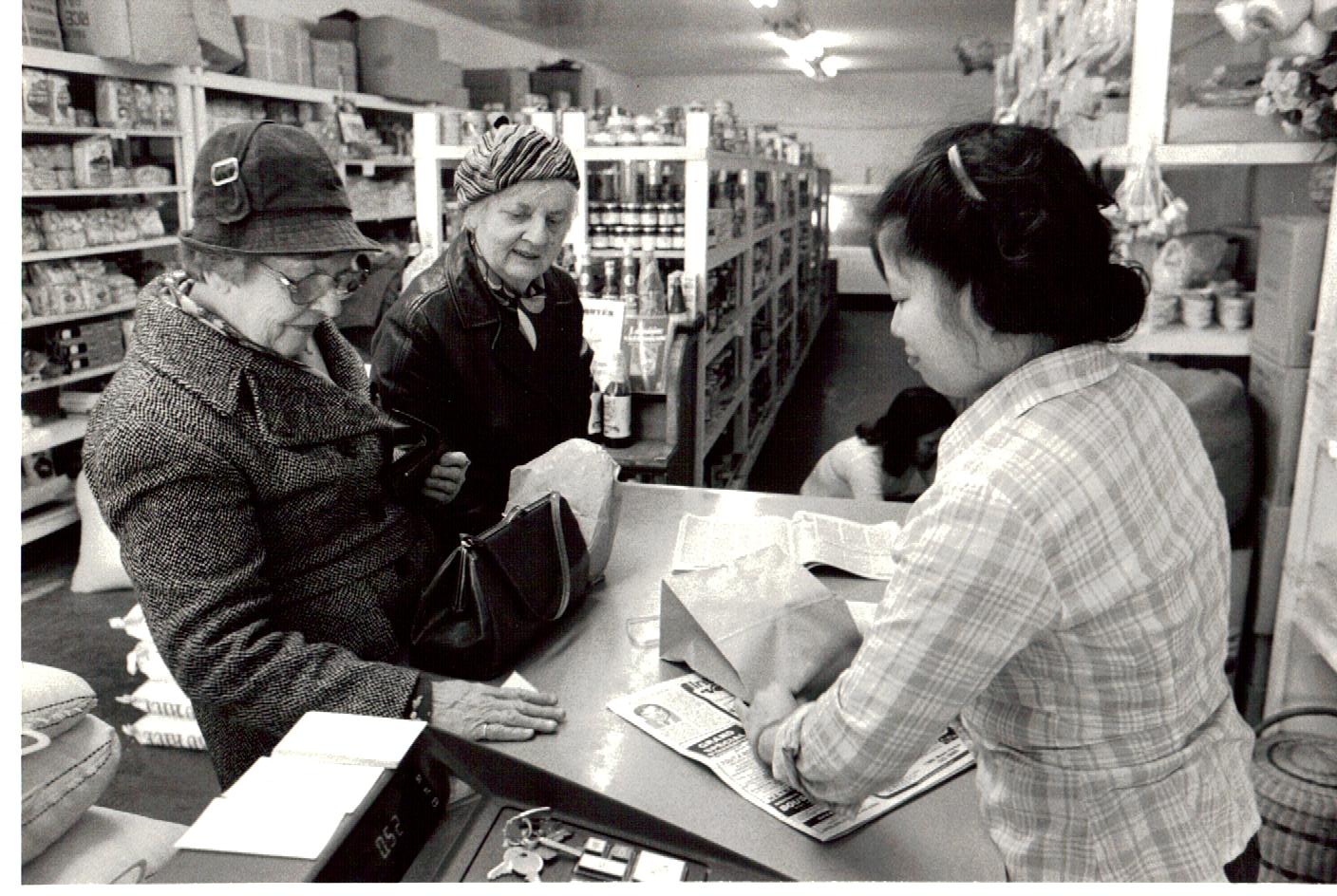A hundred years of immigration to Canada 1900 - 1999
A chronology focusing on refugees and discrimination
Part 1: 1900 - 1949
| 1900 | 41,681 immigrants were admitted to Canada. |
| 1896-1905 | Clifford Sifton held the position of Minister of Interior (with responsibilities for immigration). He energetically pursued his vision of peopling the prairies with agricultural immigrants. The immigrants he sought for the Canadian West were farmers (preferably from the U.S. or Britain, otherwise (northern) European). Immigrants to cities were to be discouraged (in fact, many of the immigrants quickly joined the industrial labour force). "I think that a stalwart peasant in a sheepskin coat, born to the soil, whose forefathers have been farmers for ten generations, with a stout wife and a half dozen children, is good quality". Immigration of black Americans was actively discouraged, often on the grounds that they were unsuitable for the climate. |
| 1900-1921 | 138,000 Jews immigrated to Canada, many of them refugees fleeing pogroms in Czarist Russia and Eastern Europe. There were also arrivals of Doukhobors from Russia, where they suffered persecution. |
| 1900 | The Head tax on Chinese immigrants was increased from $50 (set in 1885 in the first Chinese Exclusion Act) to $100. |
| 1901 | Census.(1) Of the 5,371,315 population in Canada, 684,671 (12.7%) were immigrants (i.e. born outside Canada). 57% of the immigrants were male. About a quarter of the immigrant population had arrived in the previous 5 years. 57% of immigrants were born in the British Isles, 19% in the U.S., 5% in Russia, 4% in Germany and 2.5% (17,043 people) in China. There were 4,674 people born in Japan, 1,222 people born in Syria, 357 people from Turkey, and 699 born in the West Indies. The only African country listed was South Africa (128 people). Of the 278,788 immigrants who were "foreign-born" (meaning born outside the British Empire), 55% were naturalized citizens. However, only 4% (668) of the Chinese-born were citizens. In terms of "origins", the census counted 17,437 "Negroes" in Canada. 42% of the population was of British origin, while 31% was of French origin. There were 16,131 Jews and 22,050 Chinese/Japanese (given as one category). 96% of the population was of European origin. |
| 1903 | Chinese head tax increased to $500. From 1901 to 1918, $18 million was collected from Chinese immigrants (compared to $10 million spent on promoting immigration from Europe). |
| 1906 | Immigration Act. According to Frank Oliver, Minister of the Interior, the purpose of the Act was "to enable the Department of Immigration to deal with undesirable immigrants" by providing a means of control. The Act enshrined and reinforced measures of restriction and enforcement. The categories of "prohibited" immigrants were expanded. The Act also gave the government legal authority to deport immigrants within two years of landing (later extended to three and then five years). Grounds for deportation included becoming a public charge, insanity, infirmity, disease, handicap, becoming an inmate of a jail or hospital and committing crimes of "moral turpitude". Such deportations had occurred prior to 1905 without the benefit of law, but after 1906, numbers increased dramatically. |
| 1906-1907 | c. 4,700 Indians, mainly Sikhs from the Punjab, arrived in Vancouver. Arrivals of Japanese and Chinese increased (more than 2,300 Japanese arrived in B.C. in 1907). Reaction by white British Columbians was described by the Minister of the Interior as "almost hysterical". An "Anti-Asiatic Parade" organized by the Asiatic Exclusion League ended in a riot, with extensive damage done to property in Chinatown and the Japanese quarter. |
| 1907 | A government delegation to Japan resulted in an agreement whereby the Japanese government would voluntarily limit emigration of Japanese to Canada to 400 a year. |
| 1908 | Order in council issued imposing a "continuous journey" rule, prohibiting immigrants who did not come by continuous journey from their country of origin. At the time steamships from India and Japan made a stop in Hawaii. The "landing money" required of Indians was also increased from $50 to $200. |
| 1908 | Amendments were made to Chinese Immigration Act expanding the list of prohibited persons and narrowing the classes of persons exempt from the head tax. |
| 1908 | A border inspection service was created on the U.S.-Canada border. |
| 1910 | Immigration Act. This Act gave the government enormous discretionary power to regulate immigration through Orders in Council. Section 38 allowed the government to prohibit landing of immigrants under the "continuous journey" rule, and of immigrants "belonging to any race deemed unsuited to the climate or requirements of Canada, or of immigrants of any specified class, occupation or character". The Act also extended the grounds on which immigrants could be deported to include immorality and political offenses (Section 41). The Act introduced the concept of "domicile" which was acquired after three years of residence in Canada (later five years). |
| 1910 | Black Oklahoman farmers developed an interest in moving to Canada to flee increased racism at home. A number of boards of trade and the Edmonton Municipal Council called on Ottawa to prevent black immigration. In 1911 an order in council was drafted prohibiting the landing of "any immigrant belonging to the Negro race, which race is deemed unsuitable to the climate and requirements of Canada". The order was never proclaimed, but the movement was nevertheless effectively stopped by agents hired by the Canadian government, who held public meetings in Oklahoma to discourage people, and by "strict interpretation" of medical and character examinations. Of more than 1 million Americans estimated to have immigrated to Canada between 1896 and 1911, fewer than 1,000 were African Americans. |
| 1910-1911 | First Caribbean Domestic Scheme: 100 Guadeloupian women came to Québec. |
| 1911 | Census. The population of Canada was 7,206,643, of which 22% was composed of immigrants (i.e. born outside Canada). Only 39% of those born outside Canada were female (2% of those born in China, representing 646 women). 49% of immigrants were born in the British Isles, 19% in the U.S., and 6% in Russia. 223 were identified as being born in Africa (outside South Africa), 211 in the West Indies. Of the 752,732 immigrants who were "foreign-born" (meaning born outside the British Empire), 47% were naturalized citizens. 9.5% (2,578) of the Chinese-born and 22.5% (1,898) of the Japanese-born were citizens. In terms of "origins", the census counted only 16,877 "Negroes", 560 fewer than in 1901. 54% of the population was of British origin (up from 47% in 1901), while 29% was of French origin. There were now 75,681 Jews, 27,774 of Chinese origin, 9,021 of Japanese origin and 2,342 were classified as "Hindu". 5% of the population had German origins and 1.8% Austro-Hungarian. 97% of the population was of European origin. |
| 1912-1914 | Dominion Iron and Steel Company sent two Barbadian steelworkers to Barbados to recruit steelworkers. |
| 1913 | Immigration reached a record level of 400,810 new arrivals (the highest level in the century). Taken as a proportion of the population at the time, it was equivalent to present-day Canada receiving about one and half million immigrants in a year. |
| June 1914 | An MP in the House of Commons: "How can we go on encouraging trade between Canada and Asia and then hope to prevent Asiatics from coming into our country?" |
| 1914 | The Komagatu Maru arrived in Vancouver, having sailed from China with 376 Indians aboard, who were refused admittance to Canada. After two months in the harbour, and following an unsuccessful appeal to the BC Supreme Court, the boat sailed back to India. Between 1914 and 1920 only one Indian was admitted to Canada as an immigrant. |
| 1914 | The War Measures Act was passed, giving the government wide powers to arrest, detain and deport. "Enemy aliens" were forced to register themselves and subjected to many restrictions. In the course of the war, 8,000-9,000 "enemy aliens" were interned. Many were subsequently released in response to labour shortages. |
| 1915-19 | Very limited immigration during the war. |
| 1917 | The Wartime Elections Act disenfranchised all persons from "enemy alien" countries who had been naturalized since 1902. |
| 1917 | The Office of Immigration and Colonization was created by order in council. |
| 1917 | About 4,000 Hutterites immigrated to Alberta from South Dakota, where they were suffering prejudice because they were German-speaking and unwilling to sustain the military efforts. Their entry to Canada was permitted under an 1899 order in council originally intended for Doukhobors. |
| 1918 | The Industrial Workers of the World (IWW, known as the "Wobblies") and 13 other socialist or anarchist groups were declared illegal. Another order in council banned publications using Finnish, Russian, Ukrainian, Hungarian and German. The Wobblies had been for several years a primary target of government anti-agitator activities, as a result of fears of enemy alien subversion and the "Bolshevik menace", and pressure from industrialists interested in suppressing labour activism. Immigration officials used whatever measures they could find to deport IWW members. For example, one man was deported because he had "created an agitation and a disturbance by openly advocating the views of the IWW" while on a train. The legal basis for deporting him was that he had created or attempted to create a riot or public disorder in Canada (Section 41 of the Act). |
| 1918-19 | At the end of war, immigrants were dismissed from some jobs in order to offer work to returning soldiers. |
| 1919 | A Women's Division was created within the Immigration Department. Systems for the "care" of single women immigrants (mostly British in the 1920s) were developed, including meeting by women officers, escorts to final destination and long-term follow up. The government was concerned to save the women from being "ruined". Immigrant women who engaged in sexual relationships outside marriage were liable to be deported (sometimes on the grounds of prostitution, or if they had an illegitimate child, on the grounds that they had become a public charge, since they would generally be forced out of their job). |
| 1919 | Amendments to the Immigration Act were made, adding new grounds for denying entry and deportation (e.g. constitutional psychopathic inferiority, chronic alcoholism and illiteracy). Section 38 allowed Cabinet to prohibit any race, nationality or class of immigrants by reason of "economic, industrial, or other condition temporarily existing in Canada" (unemployment was then high), because of their unsuitability, or because of their "peculiar habits, modes of life and methods of holding property". In a last minute extra amendment, in response to the Winnipeg General Strike, among whose leaders were British-born activists, the British-born were made subject to deportation on political grounds. This particular amendment was repealed in 1928, after five previous efforts at repeal failed, many blocked in the Senate. |
| June 1919 | Under the authority of Section 38 of the Immigration Act, an Order in Council was issued prohibiting the entry of Doukhobors, Mennonitesand Hutterites, because of their "peculiar habits, modes of life and methods of holding property". |
| 1919 | Amendment to the Naturalization Act. Citizenship could be revoked if anyone were found to be "disaffected" or "disloyal" or if the person "was not of good character at the date of the grant of the certificate". |
| 1920 | Immigration official: "At the present moment, we are casting about for some more effective method than we have in operation to prevent the arrival here of many of the nondescript of Europe, whose coming here is regarded more in the light of a catastrophe than anything else". |
| 1921 | Census. The population of Canada was 8,787,949, of which 22% was composed of immigrants (i.e. born outside Canada). 44% of the immigrant population was female (but only 3% of the Chinese and 32% of the Italians). 82% of immigrants had been in Canada for 10 years or more. 52% of immigrants were born in the British Isles, 19% in the U.S. and 5% in Russia. 1,760 immigrants were born in South Africa; Africa is not otherwise listed as a place of birth. Of the 890,282 immigrants who were "foreign-born" (born outside the British Empire), 58% were naturalized citizens. The number of naturalized Chinese-born had decreased from 2,578 in 1911 to 1,766 (representing 4% of the Chinese-born). The number of German-born naturalized citizens had also decreased (from 23,283 in 1911 - before the war - to 21,630). 33% (3,902) of the Japanese-born were citizens. 44% of the immigrant population was rural (but only 40% of female immigrants). In terms of the "origins" of the total population, the census counted 18,291 "Negroes" in Canada, 126,196 "Hebrews", 39,587 people of Chinese origin and 23,342 of Japanese origin. 55% of the population had origins in the British Isles, while 33% was of French origin. 97.5% of the population was of European origin. |
| 1922 | Empire Settlement Act passed in the British Parliament. It provided assisted passage and training opportunities for married couples, single agricultural labourers, domestics and juveniles aged 14 - 17. 130,000 immigrants to Canada were assisted under the Act. An "Aftercare Agreement" provided for selection, supervision and assistance of female domestic workers. Between Jan. 1926 and 31 March 1931, 689 women who arrived under this agreement (4.6% of arrivals) were deported, on grounds such as "illegitimacy", "immorality", "medical", "marriage", "bad conduct" and "criminal conviction" (these were the department's reasons though not necessarily the legal bases for the deportations). |
| June 1922 | Revocation of Order in Council "modes of living and methods of holding property" as it applied to Mennonites and Hutterites, opening the door to Russian Mennonites facing persecution in communist Russia. 20,000 settled in Canada between 1923 and 1929. Doukhobors remained prohibited. |
| June 1922 | An amendment to the Opium and Narcotic Drug Act provided for the deportation of "domiciled aliens" (i.e. immigrants who had been in Canada 5 years or more) with drug-related convictions. This measure was particularly directed against the Chinese. In 1923-4, 35% of deportations by the Pacific Division were under these provisions. |
| Jan. 1923 | Order in Council issued excluding "any immigrant of any Asiatic race" except agriculturalists, farm labourers, female domestic servants, and wife and children of a person legally in Canada. ("Asia" was conceived broadly, going as far west as Turkey and Syria). |
| 1923 | Immigration official: "There are continual attempts by undesirables of alien and impoverished nationalities to enter Canada, but these attempts will be checked as much as possible at their source". |
| 1923 | After a period of post-war economic gloom and low immigration, there was a cautious encouragement of immigration. The door opened to British subjects, Americans and citizens of "preferred countries" (Norway, Sweden, Denmark, Finland, Luxembourg, Germany, Switzerland, Holland, Belgium and France). Only agriculturalists, farm labourers, domestics and sponsored family members could be admitted from "non-preferred" countries: Austria, Hungary, Poland, Romania, Lithuania, Estonia, Latvia, Bulgaria, Yugoslavia and Czechoslovakia. Southern Europe was not even mentioned. |
| June 1923 | Chinese Immigration Act. This Act prohibited all Chinese immigrants except diplomats, students, children of Canadians and an investor class. Aside from protests from the Chinese community in Canada, there were virtually no voices of opposition. The day on which this Act came into force - July 1 - became known to Chinese Canadians as "Humiliation Day". |
| 1923-24 | The suicides of three home children led to a study by a British parliamentary delegation into this program which sent children from Britain into indentured labour in Canada. Some were orphans, but most left parents behind. About 100,000 children immigrated to Canada through the program, which lasted from 1868 until the 1930s. In 1925, following the delegation's report, the Canadian government put a stop to immigration of children under 14 years of age unaccompanied by parents. |
| 1925 | The Railway Agreement was signed by the Canadian Pacific and Canadian National Railways and the government, providing for the railways to recruit immigrants, including from the "non-preferred" countries of Northern and Central Europe. More than 185,000 Central Europeans entered Canada under the agreement (1925-1929). |
| 1929 | The Canadian Mennonite Board of Colonization desperately sought admission for 1,000 Mennonite families facing deportation to Siberia. The Saskatchewan government refused them outright, as in turn did other prairie provinces. Eventually 1,300 Mennonites were able to enter, mostly settling in Ontario. |
| 1930 | As the depression took hold, the number of deportations on the grounds of "becoming a public charge" rose. From 1930 to 1934, 16,765 immigrants were deported on this ground (more than 6 times as many as in the previous 5 year period). The numbers of deportations on the grounds of medical causes and criminality also increased. |
| Sept. 1930 | Order in Council (P.C. 2115) issued prohibiting the landing of "any immigrant of any Asiatic race", except wives and minor children of Canadian citizens (and few Asians could get citizenship). |
| 1931 | Order in Council requiring Chinese and Japanese to renounce their former citizenship before being naturalized. This effectively barred Japanese from becoming citizens since Japanese law did not provide for revocation of citizenship. In any case since 1923 very few Asians applying for naturalization were approved in what was a highly discretionary process. |
| 1931 | Census. The population of Canada was 10,376,786, of whom 22% were immigrants (i.e. born outside Canada). 44% of immigrants were female (but only 14% of Asian immigrants), 67% had been in Canada more than 10 years and 40% lived in rural localities. 49% of immigrants were born in the British Isles, 15% in the U.S., 14% in Central Europe and less than 3% in Asia. Africa only appears as a place of birth in South Africa. 1,296 people were listed as born in South America. 55% of the foreign-born population were naturalized citizens. In terms of "racial origins", 52% of the total population had origins in the British Isles, 28% in France. There were 156,726 Jews, 84,548 people of "Asiatic" origin and 19,456 "Negroes". 97.7% of the population was of European origin. |
| 1931 | Deportations of immigrants who had organized or participated in strikes or other organized labour activities. Winnipeg Mayor Ralph Webb campaigned to deport and prevent the admission of communists and agitators. He urged the "deportation of all undesirables". |
| March 1931 | In the context of the depression, an Order in Council was adopted (P.C. 695) restricting admission to American citizens, British subjects and agriculturalists with economic means. |
| August 1931 | The Communist Party was made illegal under the Criminal Code. Even naturalized immigrants who were members of the Party could have their citizenship revoked and be deported. |
| Fall 1931 | Political deportation became federal policy. The Minister of Justice hosted a special meeting attended by the Minister of National Defence, the Commissioner of Immigration, the military chief of staff and the RCMP Commissioner. The exact number of people deported on political grounds is unknown, because they may technically have been deported on other grounds, e.g. criminal conviction, vagrancy or being on the public charge. |
| Early 1930s | Widespread deportation of the unemployed (28,097 people were deported 1930-1935). Following an outcry, the department changed its policy at least so far as to suspend deportations against those who had found work by the time the deportation orders were ready. |
| May 1932 | In a "red raid" left-wing leaders from across Canada were arrested and sent to Halifax for hearings and deportations. One of them was a Canadian citizen by birth. He sued the government for false arrest, but despite criticisms from the Manitoba Court of Appeal of the Department's failure to follow due process, he lost in a 3-2 decision. The others, known as the "Halifax Ten", lost their appeal before the Nova Scotia Supreme Court (although the Court agreed that the department had not acted in complete conformity with the law). Despite extensive protests, they were deported. |
| 1934 | 94% of applications for naturalization were refused. Confidential RCMP assessments led to refusals on the basis of political or labour activism or perceived "bad character". |
| 1936 | Immigration became part of the Department of Mines and Resources. |
| 1937 | Annual report, Immigration: "There is at present a great pressure at our doors for the admission of many thousands of distressed peoples of Europe". |
| 1938 | A number of individuals and groups, including the Anglican Church, the United Church, the YMCA, local service clubs and the Co-operative Commonwealth Federation (CCF), as well as Jewish community groups, called on the government to admit Jewish refugees. They were opposed by such groups as the Native Sons of Canada, Leadership League and Canadian Corps. Voices of anti-Semitism were particularly strong in Quebec. |
| March 1938 | F.C. Blair, Director of Immigration Branch (an anti-Semite, who personally ensured that virtually no Jews were admitted to Canada during this period): "Ever since the war, efforts have been made by groups and individuals to get refugees into Canada but we have fought all along to protect ourselves against the admission of such stateless persons without passports, for the reason that coming out of the maelstrom of war, some of them are liable to go on the rocks and when they become public charges, we have to keep them for the balance of their lives". |
| July 1938 | Canada participated (reluctantly) at the Evian Conference on refugees. Canadian representatives were under instructions from Prime Minister Mackenzie King not to support the creation of a permanent structure to handle refugee matters or any initiatives to commit countries to quotas of refugees. |
| Oct. 1938 | At a meeting of the League of Nations Society of Canada the Canadian National Committee on Refugees and Victims of Persecution was formed. Since the government blamed its unwillingness to admit refugees on lack of public support, the committee focused on public education, setting up branches, organizing public meetings and producing a pamphlet "Should Canada admit refugees?" Unsuccessful in effecting any policy change, the committee intervened in individual cases, sometimes with positive results. Among the refugees admitted were the Czech industrialist Thomas Bata and 82 of his workers. |
| 1938 | Memo to Mackenzie King by Departments of External Affairs and Mines and Resources: "We do not want to take too many Jews, but in the circumstances, we do not want to say so. We do not want to legitimise the Aryan mythology by introducing any formal distinction for immigration purposes between Jews and non-Jews. The practical distinction, however, has to be made and should be drawn with discretion and sympathy by the competent department, without the need to lay down a formal minute of policy". |
| Nov. 1938 | Britain asked Canada to take some Sudeten German refugees who had fled the Nazis to Prague. The railroad companies were sent to investigate potential immigration of farmers and glassworkers. Canada agreed to take 1,200 but insisted on Britain paying $1,500 per family for transportation and resettlement costs (Britain had offered $1,000). While negotiations were going on, Germany occupied the rest of Czechoslovakia, preventing the resettlement of most of the refugees. 303 families and 72 single men who had previously managed to get to Britain were resettled in B.C. and Saskatchewan. They had little or no farming experience, but were not allowed to settle in the cities. |
| Dec. 1938 | Responding to the refugee crisis, the government simply restated its general policy: refugees who met the categories for admissible immigrants according to the regulation in force (P.C. 695) could come to Canada. |
| 1939 | The St Louis sailed from Germany with 930 Jewish refugees on board. No country in the Americas would allow them to land. 44 prominent Torontonians sent a telegram to the Prime Minister of Canada urging that sanctuary be given to the refugees, to no avail. The ship was forced to return to Europe where many of the refugees died at the hands of the Nazis. |
| 1940 | In a comparative study of deportation in Britain, Northern Ireland, Canada, South Africa, Australia and New Zealand, C.F. Fraser found Canadian practices the most arbitrary and the Canadian judiciary apathetic: "the most notable feature of deportation cases in Canada is the apparent desire to get agitators of any sort out of the country at all costs... [T]he executive branch of the government, in its haste to carry out this policy ... displayed a marked disregard for the niceties of procedure". |
| 1940 | 2,500 male "potentially dangerous enemy aliens" interned by Britain were brought to Canada. They were housed in high security camps. In fact many of them were Jews. In 1945 they were reclassified as "interned refugees (Friendly Aliens)". 972 accepted an offer to become Canadian citizens. Many went on to prominent careers in academia or the arts. |
| 1941 | Census. The population of Canada was 11,506,655, of which 17.5% was composed of immigrants (i.e. born outside Canada). 45% of the immigrant population was female. Only in the case of immigrants from the U.S. were there more women than men. 90% of immigrants had been in Canada for 10 years or more (33% for more than 30 years). 44% of immigrants were born in the British Isles, 14% in the U.S., 7% in Poland and 5% in Russia. There were 29,095 immigrants from China (of whom only 1,426 were women), 9,462 from Japan and 5,886 other "Asians" (includes "Arabian, Armenian, Hindu, Syrian, Turkish..."). No African countries are listed. While 47% of the total population was rural, only 39.5% of immigrants were. However, more than half of some immigrant groups were rural: Austrians, Belgians, Czechs, Danes, Finns, Germans, Icelanders, Dutch, Norwegians and Swedes. Women immigrants were less likely to be rural than men: 37% versus 42%. Only 32% of British immigrants were rural. In terms of "racial origin", 49.7% of the population had origins in the British Isles, 30% in France, 4% were German and 2.7% were Ukrainian. There were 170,241 Jews, 34,627 Chinese and 22,174 "Negroes". 71.5% of the foreign-born were naturalized citizens (8% of the Chinese-born, 35% of the Japanese-born). 97.7% of the population was of European origin. |
| 1942 | Immigration reached its lowest level of the century: 7,576. |
| Feb. 1942 | 22,000 Japanese Canadians were expelled from within 100 miles of the Pacific. Many went to detention camps in the interior of B.C., others further east. Detention continued to the end of the war, when the Canadian government encouraged many to "repatriate" to Japan. 4,000 left, more than half Canadian-born and two-thirds Canadian citizens. |
| 1945-1947 | In the immediate post-war period, immigration controls remained tight, while pressure mounted for a more open immigration policy and a humanitarian response to the displaced persons in Europe. |
| May 1946 | Order in Council issued allowing Canadian citizens to sponsor brothers and sisters, parents and orphaned nephews and nieces. |
| May 1946 | Canadian officials were directed to accept identity documents and travel documents in lieu of passports from displaced persons. |
| July 1946 | The government decided to admit 3,000 Polish veterans. They were obliged to work on a farm for one year after their arrival in Canada. |
| 1946 | Canadian Citizenship Act adopted, creating a separate Canadian citizenship, distinct from British (Canada was the first Commonwealth country to do so). |
| Nov. 1946 | The Prime Minister announced emergency measures to aid the resettlement of European refugees. It was some months before anything was done concretely, and the door did not open for refugees without relatives in Canada until mid-1947. Selection of refugees was guided by economic considerations (the Department of Labour was involved), ethnic prejudices (Jews were routinely rejected) and political bias (those with left-wing or Communist sympathies were labelled "undesirables"). Refugees also had to be in good health. An External Affairs officer claimed that Canada selected refugees "like good beef cattle". |
| Jan. 1947 | Italians were removed from the category of "enemy aliens" leading to a period of significant Italian immigration. |
| April 1947 | Beginning of the Displaced Person (DP) movement. 186,154 displaced persons came to Canada between 1947 and 1952. |
| 1 May 1947 | Prime Minister Mackenzie King made a statement in the House outlining Canada's immigration policy. "The policy of the government is to foster the growth of the population of Canada by the encouragement of immigration. The government will seek by legislation, regulation, and vigorous administration, to ensure the careful selection and permanent settlement of such numbers of immigrants as can advantageously be absorbed in our national economy." Regarding discrimination, he made it clear that Canada is "perfectly within her rights in selecting the persons whom we regard as desirable future citizens". Still, he allowed that it might be as well to remove "objectionable discrimination". On the other hand, "the people of Canada do not wish, as a result of mass immigration, to make a fundamental alteration in the character of our population. Large-scale immigration from the orient would change the fundamental composition of the Canadian population". |
| 1 May 1947 | Order in Council issued allowing legal residents (and not just citizens) to sponsor fiancé(e)s, spouses and unmarried children. |
| May 1947 | Chinese Immigration Act repealed, following pressure, e.g. by the Committee for the Repeal of the Chinese Immigration Act, formed by church and labour groups. Chinese immigration was henceforth regulated by the 1930 rules for "Asiatics" which allowed only the sponsorship of wife and children by Canadian citizens. |
| August 1948 | The first of a total of 9 boats carrying 987 Estonian refugees arrived on the east coast of Canada. They sailed from Sweden, where they were living under threat of forced repatriation to the Soviet Union. They had been trying to resettle to Canada but had been frustrated by the long delays and barriers in Canadian immigration processing. They were detained on arrival and processed through an ad hoc arrangement. All but 12 were accepted (the 12 were deported). |
(1) The figures from the census need to be viewed with caution, since there are numerous distorting factors. Groups discriminated against tend in particular to be underrepresented. The ways in which the census-takers categorized the population are in themselves revealing.

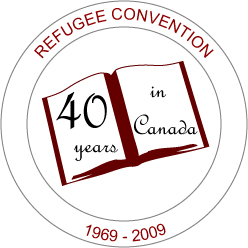 On 4 June 1969, Canada belatedly signed the Convention relating to the Status of Refugees, 18 years after it was adopted by the United Nations, and 15 years after it entered into force.
On 4 June 1969, Canada belatedly signed the Convention relating to the Status of Refugees, 18 years after it was adopted by the United Nations, and 15 years after it entered into force.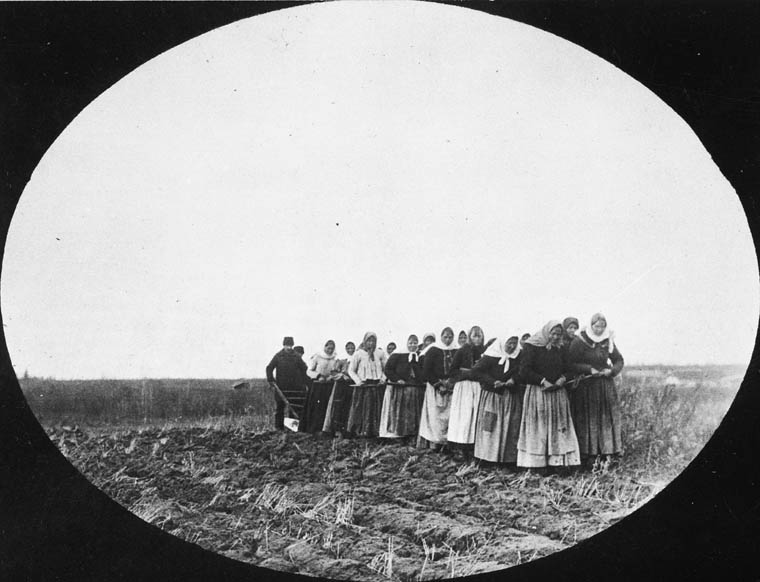
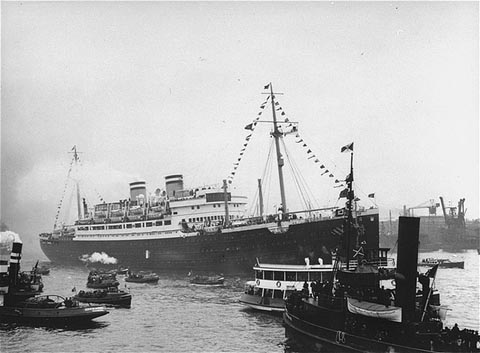

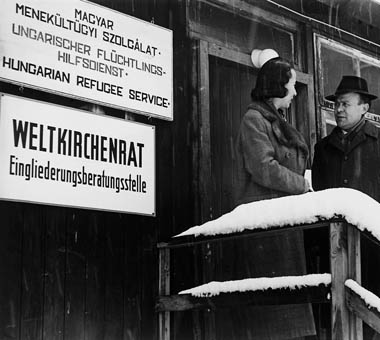
 The people of Canada were awarded the Nansen medal by the UN High Commissioner for Refugees, in “recognition of their major and sustained contribution to the cause of refugees”.
The people of Canada were awarded the Nansen medal by the UN High Commissioner for Refugees, in “recognition of their major and sustained contribution to the cause of refugees”.